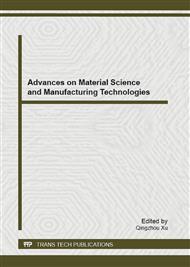[1]
D. Y. Feng, Y. G. Nie, R. Z. Guo, G. Y. Wu, Tectonic waves and their applications to earthquake prediction. Crustal Deformation and Earthquake. 1993, 13(1), pp.1-13. (in Chinese with English abstract).
Google Scholar
[2]
D. Y. Feng, Q. L. Pan, S. H. Zheng, Long-period deformational waves and short term and imminent earthquake precursors. Acta Seismologica Sinica. 1984, 6(1), pp.41-57. ( in Chinese with English abstract).
Google Scholar
[3]
Z. Y. Li, D. F. Chen, Y. L. Wu, X. J. Li, Study on Characteristics selection and its classification effect of tilt precursory observations, Acta Seismologica Sinica. 1996, 18(4), pp.470-474.
DOI: 10.1007/bf02651050
Google Scholar
[4]
S. R. Mei, D. Y. Fen, China Overview of Earthquake Prediction, Earthquake Press, Peking, 1993.
Google Scholar
[5]
D.M. Wu, D. Y. Han, Processing three kinds of deformation data of the dahuichang station before and after tangshan earthquake by the multichannel winner filtering method. Acta Seismologica Sinica. 1983, 5(1), pp.31-38. (in Chinese with English abstract).
Google Scholar
[6]
R. S. Zeng, Introductory Theory of The Solid Geophysics. Science Press, Peking, 1984.
Google Scholar
[7]
D. Y. Han, H. Z. An, L. Gu, Analysis of deformation data before and after earthquake by mixed regression method with spare coefficients. China Earthquake. 1985, 1(2), pp.67-73. (in Chinese with English abstract).
Google Scholar
[8]
A. P. Venedikov, J. Arnoso, R. Vieira, New version of the program VAV f or tidal data processing. Comput Geosci. 2005, 3(1), pp.667-669.
DOI: 10.1016/j.cageo.2004.12.001
Google Scholar
[9]
A. T. Doodson, The Harmonic development of the tide-generating potential, International Hydrographic Review. 1954, Vol. XXXI, No 1.
Google Scholar
[10]
Q. W. Xi, Precise development of the tidal generating potential and some explanatory notes, Chinese Journal Geophysics. 1991, 34(2), pp.182-194.
Google Scholar
[11]
W. C. Yang, The theory and method of geophysical inversion, Geological Press, 1997.
Google Scholar
[12]
Z. Y. He, The Adaptive Signal Process. Science Press, Peking, 2002.
Google Scholar
[13]
Y. Wu, Y. G. Ge, Adaptive notch filter based on LMS algorithm and its application in ground tilt data processing. The 2nd International Conference on Consumer Electronics, Communications and Networks (CECNet 2012), April 21st~23rd, HuBei, China.
DOI: 10.1109/cecnet.2012.6201531
Google Scholar
[14]
A. F. Niu, Study on the sudden changes ground tilt and earthquakes. Acta Seismologica Sinica. 2003, 25(4), pp.441-445. (in Chinese with English abstract).
Google Scholar
[15]
J. Li, Z. Y. Zhou, S. L. Lu, C. Y. Lu, Contrast and analysis of digital and analogic deformation data at stations in shandong province, Journal of Geodesy and Geodynamics. 2003, 23(1), pp.85-92. (in Chinese with English abstract).
Google Scholar
[16]
R.LaColazet, Application a l'analyse des observations de maree gravimetrique, de la method de H. et Y. Labrouste dite par combinaisions lineaires d'ordonnees, Annales de Geophy. 1956, No 12 .
Google Scholar


